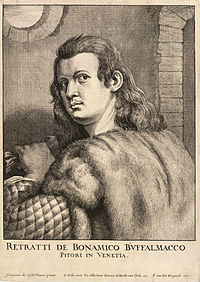
Back Buonamico Buffalmacco Catalan Buonamico Buffalmaccio Czech Buonamico Buffalmacco German Buonamico Buffalmacco Spanish Buonamico Buffalmacco French Buonamico Buffalmacco Italian ブオナミーコ・ブファルマッコ Japanese Buonamico Buffalmacco LIJ Buonamico Buffalmacco PMS Buonamico Buffalmacco Portuguese
This article needs additional citations for verification. (December 2009) |
You can help expand this article with text translated from the corresponding article in Italian. (January 2009) Click [show] for important translation instructions.
|

Buonamico di Martino, otherwise known as Buonamico Buffalmacco (active c. 1315–1336), was an Italian Renaissance painter who worked in Florence, Bologna, and Pisa. Although none of his known work has survived, he is widely assumed to be the painter of a most influential fresco cycle preserved in the Campo Santo of Pisa, featuring The Three Dead and the Three Living,[1] the Triumph of Death,[2][3] the Last Judgement, the Hell, and the Thebais (several episodes from the lives of the Desert Fathers).
Painted some ten years before the Black Death spread over medieval Europe in 1348, the cycle enjoyed an extraordinary success after that date, and was often imitated throughout Italy during the Renaissance. The youngsters' party enjoying themselves in a beautiful garden while Death piles mounds of corpses all around is likely to have inspired the setting of Giovanni Boccaccio's literary masterpiece The Decameron, written a few years after the spread of the Black Death (1348–1353).